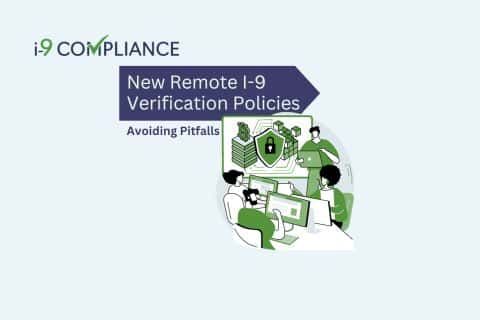Avoid Pitfalls When Using New Remote I-9 Verification Policies

September 19, 2023
Employers using E-Verify and maintaining good standing can complete the employment eligibility verification (Form I-9) remotely. However, employers must ensure they qualify before using remote verification. They may participate in remote verification by adhering to the following requirements for good standing:
- “[Being] enrolled in E-Verify with respect to all hiring sites that use the alternative procedure to remotely examine documents,
- Us[ing] E-Verify to confirm the employment eligibility of newly hired employees in the United States, and
- Compl[ying] with all other requirements of the E-Verify program.”
Qualified employers can remotely verify their employees’ I-9 documents. When verifying remotely, they must observe the employee’s process during a live video interaction. They must watch the employee fill out Section 1 of Form I-9 and verify the presented documents’ genuineness and relation to the employee.
Employers must receive consent from the employee if they wish to record the interaction. This precaution ensures they comply with local laws, as privacy regulations may vary. Though the DHS does not require employers to record these video sessions, it did stress the importance of consistency. Should an employer choose to record one verification process, they should record the process for every employee. This consistency ensures that the employer does not discriminate against anyone.
During this interaction, the employee must send copies of the form and documentation to the employer. Employers must be careful during this step because they cannot request specific documentation. Instead, they must allow employees to choose which documents to present if they fulfill Form I-9 requirements. Again, employers should not ask for documentation beyond what Form I-9 requires.
Employers should offer clear instructions for employees ready to present eligible documentation. They should also prepare for situations when the employee provides excess information. The DHS’s Immigrant and Employee Rights Department may investigate businesses requiring unnecessary documentation. Requesting additional information due to an employee’s citizenship or national origin violates the Immigration and Nationality Act (INA). Violating anti-discrimination laws like this can lead to significant fines or penalties.
After completing the live video interaction, the employer must check the box in the Additional Information Field of the new Form I-9. Should the employer use the previous version, they must write “Alternative Procedure” in this field. Employers must retain copies of all documents they remotely verified for the Form I-9s.
Completing Form I-9 can confuse anyone regardless of whether an employer uses remote or physical verification. The best way to ensure correct and completed Form I-9s is to use an electronic I-9 management system with optional E-Verify integration. This system will guide employers through the process and securely store the forms and documentation.
Automate your employment eligibility verification today with the ensured compliance of I-9 Compliance.